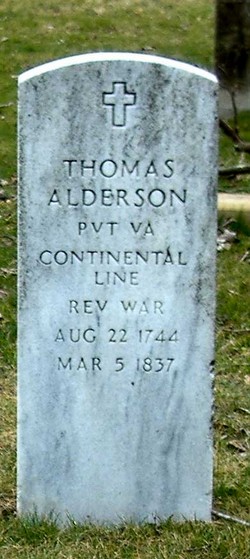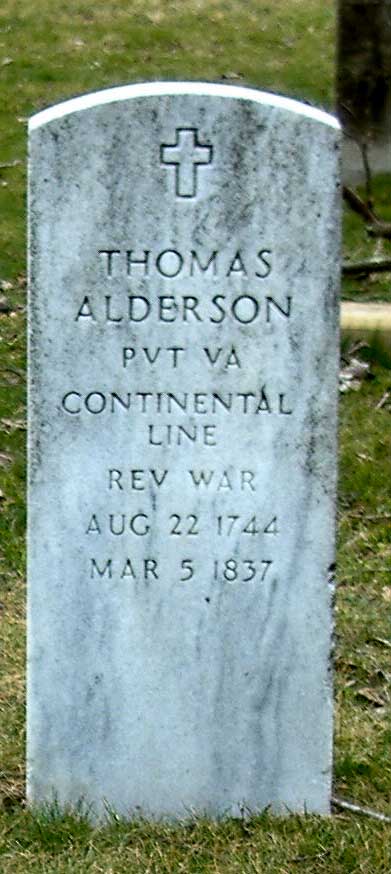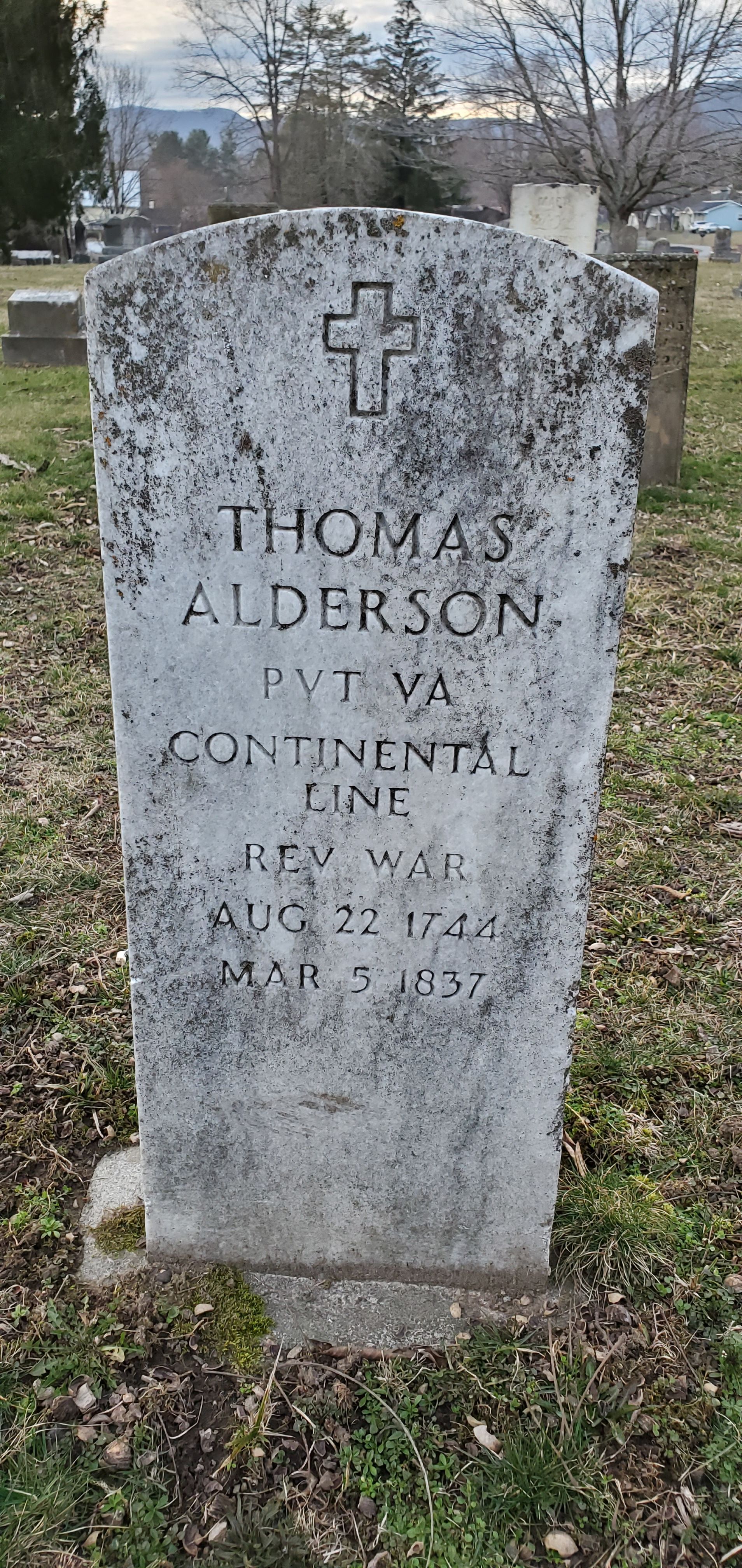"In the same year that the Aldersons came to Virginia, John Davis, the minister at the Pennepak Church, in Philadelphia, moved to Baltimore (later Harford Co., MD to join with a Baptist church there. John Davis and the senior John Alderson must have been acquainted, perhaps from Bucks County, or from activities in the Baptist Church, and they continued this acquaintance after moving to Virginia and Maryland. In 1767, Thomas was back in Baltimore Co., where he married Hannah Davis, a daughter of John and Jane Davis, on 15 Dec. Thomas may have stayed a year or so in Maryland, but he was back in the Shenandoah Valley by 1769 where his son Davis was born. His presence is also attested by a survey taken for Thomas of 80 acres in Augusta Co., lying on Daniel James' branch of Smith's Creek, and neighboring Jacob Woodley, Looker, and Carols; the survey was entered in the land book for what is now Rockingham Co. on 2 Nov 1770...Thomas' wife Hannah gave birth to daughter Hannah on 7 October 1777, shortly after which she died.
"Thomas apparently maintained his connections with Maryland, since by 22 November 1778 he had returned to marry Sarah (Bond) Smithson, widow of Thomas Smithson, Jr. in Baltimore Co. The newly married couple probably returned to Rockingham Co. a short time after...Thomas participated as a buyer in the sale of the estate of old Augusta resident and neighbor John Harrison on 16 September [1779].
"Thomas' life on Smith Creek changed abruptly in September 1780, when he was drafted for three months into military service under Capt. Jeremiah Ragan; he was marched to Richmond, where he stood guard at a jail holding "Robers and Torys, 5 of whom (as he was told) were condemned to be hanged." The shortage of provisions faced by the Continental Army at the time can be imagined from an incident related in Thomas' pension application: "a short time before his three months had expired, a proposition was made by a regular officer, his name not recollected, that if the Militia would give up their Blankets and tent cloths for the use of the Army that they might go home, which was agreed by the Militia officers." Thomas returned home in time for Christmas...In June 1781...he was again drafted, this time for a period of 20 days, and marched again to Richmond. Thomas arrived in Richmond during or shortly after the burning of the city by the British, and he left there with the army to march on to Williamsburg. At Kent Court House (now New Kent, VA), the army ran into the British, and the troops, under the command of Col. Harrison of Rockingham Co., were ordered 'to turn a little to the left where they remained about two hours for the British to get out of the way." This incident was followed by a skirmish at a place named Hot Water, where Thomas was finally discharged.
"...in September, 1781, he was again drafted for three months under Capt. Coger, and was appointed by Col. Daniel Smith to be quartermaster to the troops. The troops, again marching to Williamsburg by way of the Swift Run Gap, in the Blue Ridge Mountains, continued on to Yorktown, where the troops joined with those of General George Washington in the final stand against Lord Cornwallis' British troops. In Yorktown, Thomas joined a scouting party which lost several men as the soldiers, under the command of Col. Lewis and Major Lockhard, attempted to take a redoubt. Thomas Alderson was one of a few historic few who witnessed the surrender of Cornwallis on 19 October 1781. His service ended with his assignment to guard duty for British troops, but he was soon appointed to take care of sick soldiers and to try to get them home. Thomas notes in his pension application that he spent two thousand dollars to get the sick soldiers home, and received nothing but $1.25 in return from a grateful soldier.
"According to Thomas' pension application, after the war he moved to Greenbriar Co., "that part of which is now Monroe, and has resided where he now lives for fort-nine years.' This would place his move in 1782 at the earliest, a date consistent with his statement that he returned from Yorktown 'about the 1st of December [1781].' The minutes of the Greenbriar Baptist Church, however, note that Thomas was a charter member of the church, organized on 14 November 1781. Whether Thomas erred in his recollection of the events following Yorktown or he was considered a charter member in absentia of the Greenbriar Baptist Church cannot be determined, but given the date of Cornwallis' surrender, it is unlikely Thomas could have finished the terms of his enlistment, returned to Rockingham, and moved to Greenbriar in less than one month's time.
"Thomas quickly adjusted to the possibilities on the Greenbriar frontier. Property being plentiful and cheap, most settlers were able to acquire much larger tracts than available further East. In May, 1785, Thomas' nephew George Alderson, who was prominent in the settlement of Kanawha County, entered for him 10 acres near 2-mile Creek of Elk River (in present-day Kanawha Co. near Charleston and 2 acres on Twentymile Creek of Gauley River (now in Nicholas Co. near Belva.) Perhaps the freedom of the frontier was instrumental in affecting his behavior, for which he received criticism from the church; in September, 1788, his "unruly passions threatening the Church and refusing to hear the Church" led to his excommunication. At the time, this was a serious charge---but Thomas eventually repented and was received back into the church. In 1789, Thomas had made a survey of a 320-acre tract of land lying on the south side of the Greenbrier River near Wolf Creek; as assignee of George Alderson, he received this land (granted in 1793) as part of the same Land Office Warrant for 1,916.5 acres, dated 300 July, 1783, for which George had patented his and Thomas' other lands in Kanawha and Nicholas Counties.
"The Court Orders of 24 April 1792 named Thomas as the appointed overseer of the 'road from the river at John Alderson's to the foot of Fishbrough Hill, with the tithables from David Jerritt's and up the river, including Graham's company to clean and keep same in repair.' In August 1793, Thomas and wife Sarah appeared in court at the suit of James Kitchen against James Dyche, who seem to have spent much of the 1790's exchanging suits. Two years later, in August, 1795, Thomas and nephew George Alderson served as jurors on a case that found James Mayse guilty in his suit against Daniel Fear. As this case ended, Thomas found himself appointed as processioner in a district laid off within the bounds of Capt. Elijah Garten's militia company." In the summer of 1796, "Thomas acted as assignee of Joseph Parsons in accepting a bounty for a wolf's head.
"Thomas added more property to his estate in 1798 when he was granted 86 acres on Lick Creek, north over Keeney's mountain in present-day Summers county. He then appeared as plaintiff in court May 1799, when he argued cases against David Jarrett and Bradley Meredith on behalf of his son John. Both cases were dismissed.
In 1799, he is listed as a resident property-holder of Monroe County, recently split off of Greenbrier He and Sarah are enumerated with 2 daughters in 1810. "...in May 1811 at the age of 66, he and Thomas Creigh appeared in Lewisburg court to prove a deed presented by John Hutsenpillar. In 1820, at age 76, Thomas was head of a household including wife Sarah and perhaps son John. By 1830, Thomas and Sarah no longer lived in on their own; both, now in their 80's, are found living with John M. Alderson, in Monroe Co.
____________________
His actual burial place is unknown. The marker has been place at the Old Greenbrier Church since he was a charter member and brother of the founder.
"In the same year that the Aldersons came to Virginia, John Davis, the minister at the Pennepak Church, in Philadelphia, moved to Baltimore (later Harford Co., MD to join with a Baptist church there. John Davis and the senior John Alderson must have been acquainted, perhaps from Bucks County, or from activities in the Baptist Church, and they continued this acquaintance after moving to Virginia and Maryland. In 1767, Thomas was back in Baltimore Co., where he married Hannah Davis, a daughter of John and Jane Davis, on 15 Dec. Thomas may have stayed a year or so in Maryland, but he was back in the Shenandoah Valley by 1769 where his son Davis was born. His presence is also attested by a survey taken for Thomas of 80 acres in Augusta Co., lying on Daniel James' branch of Smith's Creek, and neighboring Jacob Woodley, Looker, and Carols; the survey was entered in the land book for what is now Rockingham Co. on 2 Nov 1770...Thomas' wife Hannah gave birth to daughter Hannah on 7 October 1777, shortly after which she died.
"Thomas apparently maintained his connections with Maryland, since by 22 November 1778 he had returned to marry Sarah (Bond) Smithson, widow of Thomas Smithson, Jr. in Baltimore Co. The newly married couple probably returned to Rockingham Co. a short time after...Thomas participated as a buyer in the sale of the estate of old Augusta resident and neighbor John Harrison on 16 September [1779].
"Thomas' life on Smith Creek changed abruptly in September 1780, when he was drafted for three months into military service under Capt. Jeremiah Ragan; he was marched to Richmond, where he stood guard at a jail holding "Robers and Torys, 5 of whom (as he was told) were condemned to be hanged." The shortage of provisions faced by the Continental Army at the time can be imagined from an incident related in Thomas' pension application: "a short time before his three months had expired, a proposition was made by a regular officer, his name not recollected, that if the Militia would give up their Blankets and tent cloths for the use of the Army that they might go home, which was agreed by the Militia officers." Thomas returned home in time for Christmas...In June 1781...he was again drafted, this time for a period of 20 days, and marched again to Richmond. Thomas arrived in Richmond during or shortly after the burning of the city by the British, and he left there with the army to march on to Williamsburg. At Kent Court House (now New Kent, VA), the army ran into the British, and the troops, under the command of Col. Harrison of Rockingham Co., were ordered 'to turn a little to the left where they remained about two hours for the British to get out of the way." This incident was followed by a skirmish at a place named Hot Water, where Thomas was finally discharged.
"...in September, 1781, he was again drafted for three months under Capt. Coger, and was appointed by Col. Daniel Smith to be quartermaster to the troops. The troops, again marching to Williamsburg by way of the Swift Run Gap, in the Blue Ridge Mountains, continued on to Yorktown, where the troops joined with those of General George Washington in the final stand against Lord Cornwallis' British troops. In Yorktown, Thomas joined a scouting party which lost several men as the soldiers, under the command of Col. Lewis and Major Lockhard, attempted to take a redoubt. Thomas Alderson was one of a few historic few who witnessed the surrender of Cornwallis on 19 October 1781. His service ended with his assignment to guard duty for British troops, but he was soon appointed to take care of sick soldiers and to try to get them home. Thomas notes in his pension application that he spent two thousand dollars to get the sick soldiers home, and received nothing but $1.25 in return from a grateful soldier.
"According to Thomas' pension application, after the war he moved to Greenbriar Co., "that part of which is now Monroe, and has resided where he now lives for fort-nine years.' This would place his move in 1782 at the earliest, a date consistent with his statement that he returned from Yorktown 'about the 1st of December [1781].' The minutes of the Greenbriar Baptist Church, however, note that Thomas was a charter member of the church, organized on 14 November 1781. Whether Thomas erred in his recollection of the events following Yorktown or he was considered a charter member in absentia of the Greenbriar Baptist Church cannot be determined, but given the date of Cornwallis' surrender, it is unlikely Thomas could have finished the terms of his enlistment, returned to Rockingham, and moved to Greenbriar in less than one month's time.
"Thomas quickly adjusted to the possibilities on the Greenbriar frontier. Property being plentiful and cheap, most settlers were able to acquire much larger tracts than available further East. In May, 1785, Thomas' nephew George Alderson, who was prominent in the settlement of Kanawha County, entered for him 10 acres near 2-mile Creek of Elk River (in present-day Kanawha Co. near Charleston and 2 acres on Twentymile Creek of Gauley River (now in Nicholas Co. near Belva.) Perhaps the freedom of the frontier was instrumental in affecting his behavior, for which he received criticism from the church; in September, 1788, his "unruly passions threatening the Church and refusing to hear the Church" led to his excommunication. At the time, this was a serious charge---but Thomas eventually repented and was received back into the church. In 1789, Thomas had made a survey of a 320-acre tract of land lying on the south side of the Greenbrier River near Wolf Creek; as assignee of George Alderson, he received this land (granted in 1793) as part of the same Land Office Warrant for 1,916.5 acres, dated 300 July, 1783, for which George had patented his and Thomas' other lands in Kanawha and Nicholas Counties.
"The Court Orders of 24 April 1792 named Thomas as the appointed overseer of the 'road from the river at John Alderson's to the foot of Fishbrough Hill, with the tithables from David Jerritt's and up the river, including Graham's company to clean and keep same in repair.' In August 1793, Thomas and wife Sarah appeared in court at the suit of James Kitchen against James Dyche, who seem to have spent much of the 1790's exchanging suits. Two years later, in August, 1795, Thomas and nephew George Alderson served as jurors on a case that found James Mayse guilty in his suit against Daniel Fear. As this case ended, Thomas found himself appointed as processioner in a district laid off within the bounds of Capt. Elijah Garten's militia company." In the summer of 1796, "Thomas acted as assignee of Joseph Parsons in accepting a bounty for a wolf's head.
"Thomas added more property to his estate in 1798 when he was granted 86 acres on Lick Creek, north over Keeney's mountain in present-day Summers county. He then appeared as plaintiff in court May 1799, when he argued cases against David Jarrett and Bradley Meredith on behalf of his son John. Both cases were dismissed.
In 1799, he is listed as a resident property-holder of Monroe County, recently split off of Greenbrier He and Sarah are enumerated with 2 daughters in 1810. "...in May 1811 at the age of 66, he and Thomas Creigh appeared in Lewisburg court to prove a deed presented by John Hutsenpillar. In 1820, at age 76, Thomas was head of a household including wife Sarah and perhaps son John. By 1830, Thomas and Sarah no longer lived in on their own; both, now in their 80's, are found living with John M. Alderson, in Monroe Co.
____________________
His actual burial place is unknown. The marker has been place at the Old Greenbrier Church since he was a charter member and brother of the founder.








